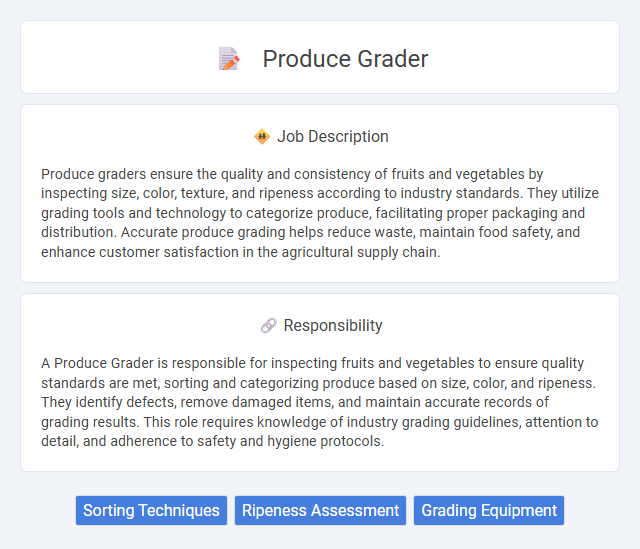
Produce graders ensure the quality and consistency of fruits and vegetables by inspecting size, color, texture, and ripeness according to industry standards. They utilize grading tools and technology to categorize produce, facilitating proper packaging and distribution. Accurate produce grading helps reduce waste, maintain food safety, and enhance customer satisfaction in the agricultural supply chain.
People with good vision and manual dexterity are likely to be suitable for a produce grader job, as the role requires accurate inspection and sorting of fresh fruits and vegetables. Those who can work efficiently in fast-paced environments and maintain attention to detail might find themselves well-suited to the physical and repetitive nature of the tasks. Individuals prone to fatigue or with difficulty standing for long periods may find this job less compatible with their condition.
Qualification
A produce grader must have a keen eye for detail and extensive knowledge of fruit and vegetable quality standards, including size, color, texture, and ripeness. Candidates typically need a high school diploma or equivalent, with on-the-job training for grading techniques and safety protocols. Experience in agricultural or food processing environments enhances the ability to accurately assess produce quality and ensure compliance with industry regulations.
Responsibility
A Produce Grader is responsible for inspecting fruits and vegetables to ensure quality standards are met, sorting and categorizing produce based on size, color, and ripeness. They identify defects, remove damaged items, and maintain accurate records of grading results. This role requires knowledge of industry grading guidelines, attention to detail, and adherence to safety and hygiene protocols.
Benefit
A produce grader job likely offers the benefit of developing keen analytical skills for assessing fruit and vegetable quality, which can enhance career prospects in agriculture and food industries. There is a good chance that this role provides hands-on experience with produce handling and quality control processes, supporting professional growth. Employees might also enjoy stable employment opportunities in seasonal and wholesale markets where product standards are critical.
Challenge
Produce grader jobs likely present challenges related to maintaining accuracy and consistency in sorting diverse fruits and vegetables. They may frequently encounter difficulties identifying subtle differences in quality, size, and ripeness under time pressure. Handling perishable goods efficiently to reduce waste could also be a common obstacle in this role.
Career Advancement
Produce grader positions offer foundational experience in quality control and inventory management, essential for growth in the agricultural and food distribution industries. Mastery in grading standards and attention to detail equips professionals for roles such as quality assurance supervisors or supply chain coordinators. Continuous skill development and certification can accelerate advancement into management and operational leadership within produce logistics.
Key Terms
Sorting Techniques
Produce graders utilize advanced sorting techniques to classify fruits and vegetables based on size, color, weight, and quality parameters using automated optical scanners and manual inspection. These methods ensure uniformity and adherence to industry standards, optimizing packaging efficiency and market value. Precision in sorting reduces waste, improves product consistency, and enhances overall supply chain effectiveness.
Ripeness Assessment
Produce graders specialize in ripeness assessment by evaluating color, texture, and firmness to ensure optimal quality and taste for consumers. They use standardized grading scales and sometimes electronic devices like firmness testers or spectrometers for precise measurement. Accurate ripeness assessment minimizes waste and maximizes shelf life, directly impacting supply chain efficiency in the agriculture and retail industries.
Grading Equipment
Produce graders utilize advanced grading equipment such as optical sorters, colorimeters, and size graders to categorize fruits and vegetables by quality, size, and color. These machines enhance accuracy and efficiency by automating the sorting process, ensuring consistent product standards and reducing human error. Efficient grading equipment plays a crucial role in maintaining produce quality for wholesale and retail distribution.
 kuljobs.com
kuljobs.com